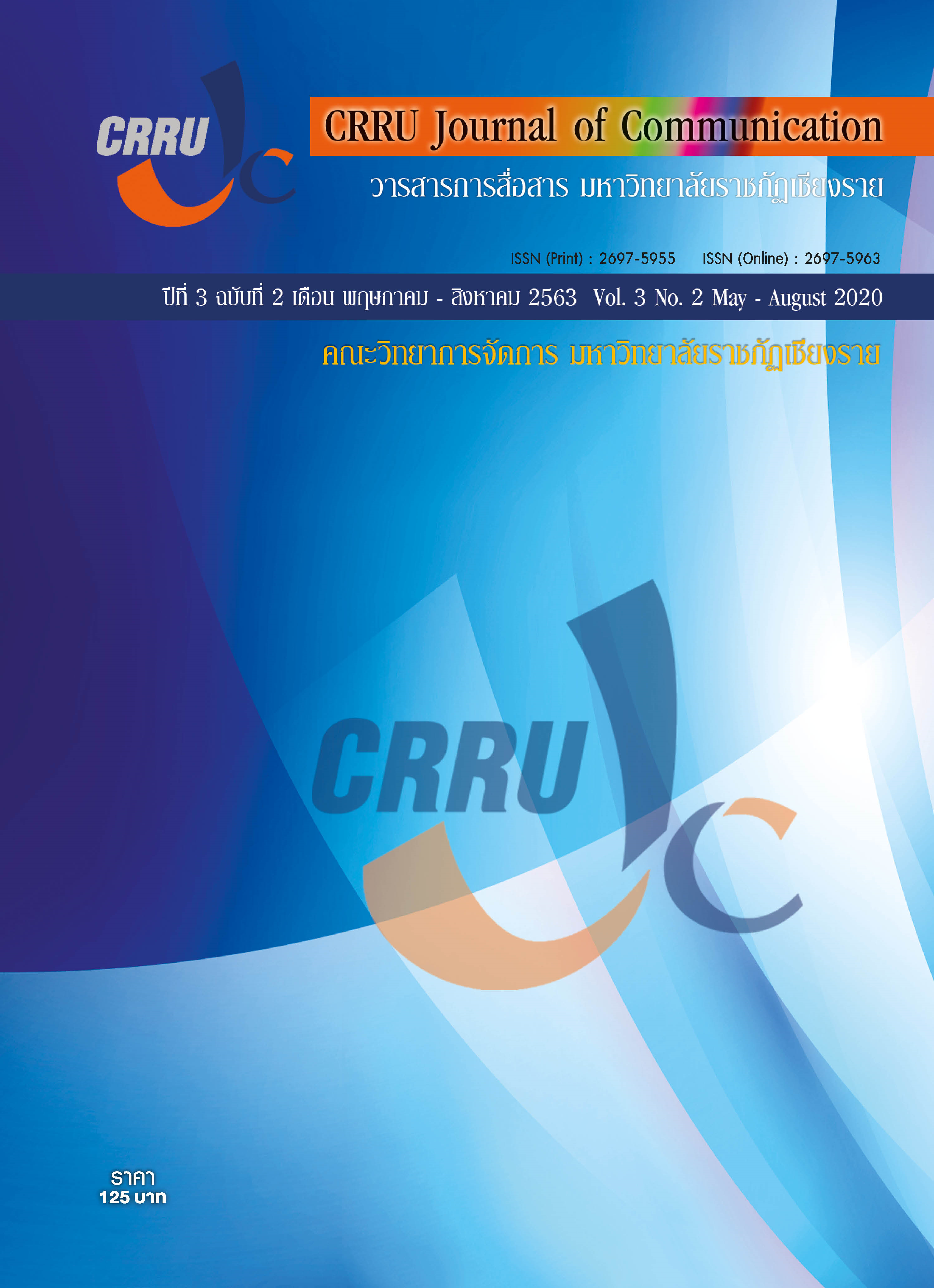Guidelines for Content Development and Communication Channels for the Ban Rong Plai Na Homestay Business, Mae Lao District, Chiang Rai Province
Main Article Content
Abstract
The objective of this research was to study the guidelines for content development and communication channels for the Ban Rong Plai Na homestay business, Mae Lao district, Chiang Rai province by using qualitative research method. Data was collected by using in-depth interviews and observation, the providing informants were Communication Arts and New Media experts, Business Administration, Marketing and Modern Trade Management Academics and the homestay operator. The research results could be summarized as follows: Guidelines for communication development for the Ban Rong Plai Na homestay business, in the composition of the message content, they should communicate to the tourists by clearly showing the issues such as 1) Products or services that were unique and different from other villages which should use "Products/Services, Push on Homestay" strategy, 2) Creating stories or schedules of new creative activities in the village, 3) Presentation of localization, rural ways, folk wisdom that becoming the identity of this community, 4) Focus on art and culture issues including valuable traditions inherited from ancestors, 5) Presentation of beautiful atmosphere, shadiness and freshness of nature, 6) Presentation of cleanliness, tidiness within the community and accommodation, 7) Presentation about food, snacks and fruits with its freshness, cleanness and pesticide residue free and 8) Dissemination of announcements in which the homestay had received a Thai homestay standard award or other awards by presenting message combined with sales promotion, allowing members of the community to be aware of the community identity, planning and acknowledging mutual benefits to promote sustainable public relations and forming community communicators who were able to produce content and distribute it through communication technology channels. For communication development guidelines for the Ban Rong Plai Na homestay business, in the composition of the communication channels, the information should be disseminated through the mainstream media via television programs, such as community tourism program and documentary program while the print media, such as brochures and leaflet, etc. For new media, they should produce and distributed via Facebook which might have to pay to increase visibility rate of the target audience on the pages frequently while distributed through YouTube channels or other online media continuously almost every week and should outline stories the whole year. In addition, after presented stories about this homestay through the old media, it was possible to bring all the content or some parts to re-distribute via online media which was to build credibility and awareness among the target group. In addition, using reviewers to comment on products and services, telling and conveying stories about different aspects of the Baan Rong Plai Na homestay and finally created tourism trend including local media such as community radio or local newspapers that closed to Chiang Rai people because they were still searching for recreation from beautiful natural resources.
Article Details
References
กรกนก นิลดำ. (2560). หลักการสื่อสาร. เชียงราย, คณะวิทยาการจัดการ มหาวิทยาลัยราชภัฏเชียงราย.
ชานิกา ฉัตรสูงเนิน. (2551). ศักยภาพในการพัฒนาที่พักแบบโฮมสเตย์ในเขตเทศบาลตำบลเวียงเชียงแสน อำเภอเชียงแสน จังหวัดเชียงราย. วิทยานิพนธ์มหาบัณฑิต สาขาการจัดการนันทนาการและการท่องเที่ยว สำนักงานบัณฑิตศึกษา มหาวิทยาลัยแม่โจ้.
ณัชชา ชัยวังเย็น. (2555). บทบาทขององค์กรปกครองท้องถิ่นในการพัฒนาการท่องเที่ยวแบบโฮมสเตย์ในพื้นที่กรณีศึกษา: เทศบาลตำบลแม่ยาว อำเภอเมือง จังหวัดเชียงราย. การศึกษาอิสระรัฐประศาสนศาสนตรมหาบัณฑิต มหาวิทยาลัยราชภัฏเชียงราย.
ณัฐชามญช์ สุวิทยพันธุ์. (2545). การเปิดรับข่าวสาร ความรู้ ทัศนคติ และแนวโน้มพฤติกรรมการท่องเที่ยวเชิงนิเวศแบบโฮมสเตย์ของนักท่องเที่ยวชาวไทย. วิทยานิพนธ์มหาบัณฑิต สาขาวิชานิเทศศาสตรพัฒนาการ ภาควิชาการประชาสัมพันธ์ คณะนิเทศศาสตร์ จุฬาลงกรณ์มหาวิทยาลัย.
บุญเลิศ จิตตั้งวัฒนา. (2542). การวางแผนพัฒนาการท่องเที่ยวอย่างยั่งยืน. เชียงใหม่: คณะมนุษยศาสตร์ มหาวิทยาลัยเชียงใหม่.
ประชัน วันลิโก และคณะ. (2550). แนวทางการประชาสัมพันธ์การท่องเที่ยวเชิงอนุรักษ์ ณ จังหวัดสมุทรสงคราม. กรุงเทพฯ: มหาวิทาลัยเกริก.
อรวรรณ พรเจริญ. (2547). การสร้างเว็บไซต์เพื่อการประชาสัมพันธ์การท่องเที่ยวแบบโฮมสเตย์ กรณีศึกษาภาคกลางและภาคใต้ของประเทศไทย. วิทยานิพนธ์มหาบัณฑิต สาขาครุศาสตร์เทคโนโลยี ภาควิชาเทคโนโลยีและการสื่อสารการศึกษา คณะครุศาสตร์อุตสาหกรรมและเทคโนโลยี มหาวิทยาลัยเทคโนโลยีพระจอมเกล้าธนบุรี.
Burnett, R. and Marshall, D. (2003). Web Theory: An Introduction. United Kingdom: Routledge.
Seubsamarn, Kanoknon. (2009). Tourist Motivation to Use Homestays in Thailand and Their Satisfaction Based on the Destination’s Cultural and Heritage-Based Attribute. Retrieved 06 1, 2019, from https://search.proquest.com/pqdtglobal/docview/905178512/5F7F3BF4D1B04063PQ/3?accountid=3208
Pavlik, J. and McIntosh, S. (2004). Converging Media: An Introduction to Mass Communication. New York: Pearson.
http://chiangrai.nso.go.th http://news.ch3thailand.com/local/48999. เมื่อวันที่ 1 มิถุนายน 2562
http://chiangrai.nso.go.th. เมื่อวันที่ 1 มิถุนายน 2562
http://www.homestaythai.net. เมื่อวันที่ 1 มิถุนายน 2562
http://chiangrai.nso.go.th เมื่อวันที่ 1 มิถุนายน 2562
https://www.nesdb.go.th. เมื่อวันที่ 1 มิถุนายน 2562


